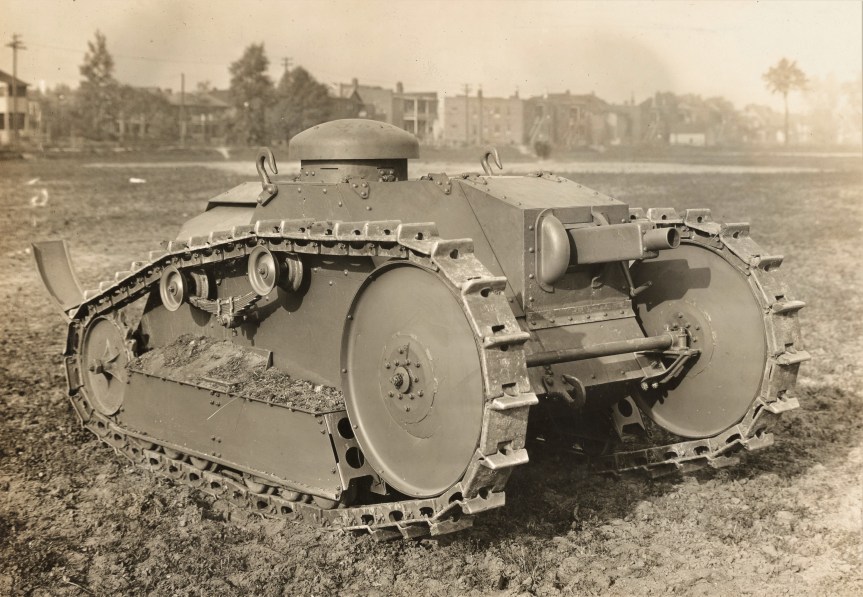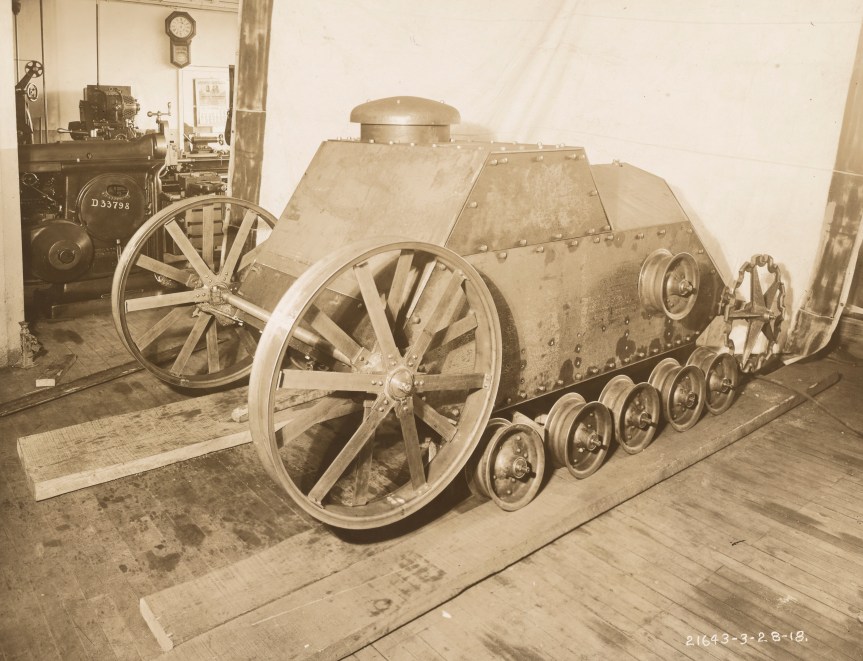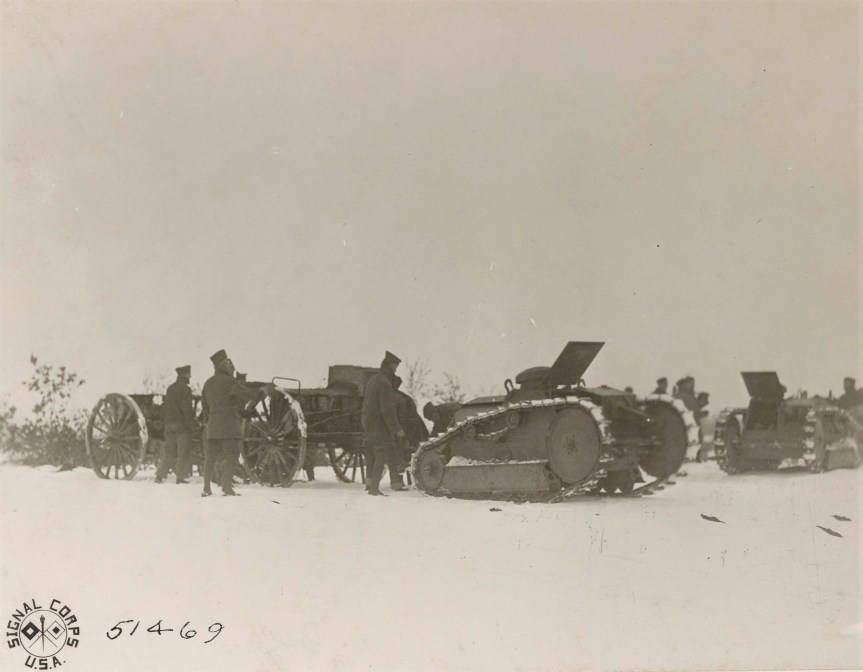When the US entered World War One in April 1917, the US Army had no experience with tanks. American observers in France had reported on the early Allied uses of tanks at the Somme and American enthusiasm for the new machines was lacking in many of the Army’s upper echelons.
This began to change after the arrival of General Pershing and his staff in France, ahead of the American Expeditionary Force. Pershing directed that a Tank Corps be raised and detailed a number of officers, including the enterprising young officer, Captain George S. Patton, to establish a training ground and report on how best to deploy tanks.
Patton was instrumental in shaping the US Army’s early tank doctrine, he wrote a highly detailed report on how to deploy tanks to maximum effect. Patton, a cavalry officer by training, admired the French Renault FT’s speed, mobility and manoeuvrability but felt the two doctrines of French light and British Heavy tanks could be combined. In December 1917, Colonel Samuel Rockenbach was placed in command of the new, but still tank-less, US Tank Corps.

Britain and France shared their tank designs with the US but in early 1918, the American automobile giant, Ford, began work on an American light tank. The result was a light and mobile tank weighing in at 3 US tons (or 2.7 metric tons). Sometimes referred to as the Ford 3-Ton Tank or the Ford Model 1918. Ford hoped to produce the new tank using as many off the shelf components, from their automobile and truck production, as they could. So the new tank was powered by two 4-cylinder Ford Model T engines, in theory developing around 40 horsepower, with a maximum speed of 8 mph and an operational range of just over 30 miles. Taking cues from the French FT, the M1918’s engines, fuel tank and transmission were mounted in a compartment at the rear of the tank. Some sources note that the tank was developed with the assistance of the Van Dorn Iron Works, in Cleveland, Ohio, presumably assisting in the manufacture of bullet-proof steel plates making up the tank’s armour.

Contemporary photographs show the prototype during assembly in one of Ford’s Detroit workshops. We’re extremely lucky to have these photos showing the development process, they show that the initial shape and layout changed very little but some important changes were made as the tank was tested. The photographs date to April 1918, suggesting that by late spring the first prototype was assembled.
Like the French FT, the M1918 had a two-man crew but was significantly lighter weighing 4 tons less. The Ford could reach speeds of up to 8 mph while the slower FT could achieve around 5 mph. The Ford M1918 was 14 feet (or 4.3m) long, making it slightly shorter than the FT. The Ford’s armour was much thinner than its French counterpart, while this helped with weight, it would have left the crew vulnerable. It had just 7 to 13mm of armour compared to the FT’s 8 to 22mm. The tank’s tracks were also extremely narrow, and while the tank was light, this could have conceivably led to issues with getting bogged down in thick mud. Some of the contemporary footage of the prototype shows it with wider, more practical looking, tracks but the later pre-production models seem to have reverted to the narrower tracks.

The earlier prototype Ford tank did not have a gun fitted and the front doors for both driver and gunner were hinged at the sides, rather than at the top. Some of the contemporary footage shows the gun-less prototype becoming trapped nose-up, at an almost 90-degree angle, after trying to cross a relatively narrow trench. To prevent this we see that the later tanks were subsequently fitted with a ‘trench tail’.
In terms of armament, the Ford was also limited with a single .30 calibre machine gun, mounted on the right side of the hull in an armoured casement. The casement doesn’t appear to have a prominent sight aperture or vision slit for the driver so how the gun was aimed is unclear. The gun also appears to have a very limited firing arc compared to the FT’s turret mounted gun, which could rotate a full 360 degrees. It is unclear exactly what sort of gun was going to be mounted in the tank although an Hotchkiss M1909 Benét–Mercié (also used in British tanks) may have been an option. Another more likely option would have been the specially-developed M1919 air-cooled Browning Machine Gun, which had been specially developed for tank mounting. Judging from the size of the armoured housing for the gun, however, it may have been intended to mount the M1918 Marlin Tank Machine Gun, which had large aluminium cooling fins.

The Ford had a two-man crew with the driver on the left and a gunner on the right. The driver also had a cupola, with vision slits, on the roof of the tank which allowed him to drive when the hatch was closed. But this must have been difficult to see out of unless the driver changed his driving position.
The tank had an exposed front axle connecting its large front track idlers, this would have been susceptible to damage from enemy fire and from hitting obstacles. At the rear is the drive sprocket and along the body of the tank are two sets of three suspension wheels with two track support rollers above. Note that the support rollers are mounted on a truck leaf spring, another example of off-the-shelf parts being utilised. This represents a change from the single support roller seen in the earlier prototype
The later footage shows as many as half a dozen pre-production tanks on the move during a demonstration at Ford’s plant in Detroit. We get a good feel for how fast and manoeuvrable the Ford tanks were. But they also struggle to navigate some of the more difficult terrain and don’t appear to have the power or traction to tackle some of the steeper hills or ditches. The tanks much have been difficult to steer, likely using a pair of clutch levers to control the tracks on either side. Two tanks even collide with each other and there’s a couple of other near misses as the Ford’s navigate around the test area. One tank becomes stuck requiring two others to pull it clear of the bank.

The War Department was eager to get tanks into production ordering 15,000 M1918s from Ford, with 500 to be delivered in January 1919 with production continuing at 100 per day after that. An initial batch of 15 were ordered for testing. At least one of these was sent to France for evaluation before the end of the war. The French were unimpressed finding it inferior to the FT, they did consider it as an artillery tractor for the French 75. The US also considered the Ford for this role and some photograph captions from early 1919, of Battery A, 140th Field Artillery, describes it as a ‘3-ton tractor’ for pulling “the new American 75mm split trail gun”, the M1916. These photographs also prove that more than one M1918 reached France.

The Ford tanks were not well regarded by those with practical experience, with the men of the US Tank Corps in France not consulted about the tank before it was ordered by the Ordnance Department. The war ended before large scale production of the M1918 could begin, With just 15 M1918s built we’re lucky to have this much film of it in action. Today only two of the Ford light tanks survive in US Army collections.

In reality the M1918 was more a Machine Gun Carrier than a tank. How effective it might have been is a matter of speculation. It’s difficult to say, while the French may not have felt it was an improvement over the FT, it certainly showed enough merit for the War Department to make a large order. Its narrow tracks, lack of protection and minimal armament may have proved to be problems. The M1918’s real legacy is that it while the US had built other tanks during the war, including the M1917, a copy of the FT, and the MKVIII heavy tank, in collaboration with the British, the M1918 Ford was the first truly American designed and built tank.
If you enjoyed the video and this article please consider supporting our work here. We have some great new perks available for Patreon Supporters.
Specifications:
Length: 14 feet / 4.3 metres
Height: 5.9 feet / 1.8 metres
Width: 5.9 feet /1.8 metres
Weight: 3 US tons / 2.7 metric tons
Powerplant: 2 Ford Model T 4-cylinder engines producing ~40HP
Speed: 8mph
Armour: 7 – 13mm
Armament: .30 calibre machine gun, likely M1918 Marlin Tank Machine Gun or M1919 Browning Tank Machine Gun
Bibliography:
Primary Sources:
All photographs and footage was sourced from the US National Archives.
Contemporary Footage:
https://catalog.archives.gov/id/7419799
https://catalog.archives.gov/id/7419811
https://catalog.archives.gov/id/7419095
https://catalog.archives.gov/id/7419804
https://catalog.archives.gov/id/7419628
https://catalog.archives.gov/id/7419174
https://catalog.archives.gov/id/89506
https://catalog.archives.gov/id/24823
https://catalog.archives.gov/id/24615
Contemporary Photographs:
https://catalog.archives.gov/id/45506351
https://catalog.archives.gov/id/45508549
https://catalog.archives.gov/id/45508547
https://catalog.archives.gov/id/45508551
https://catalog.archives.gov/id/45508430
https://catalog.archives.gov/id/45508545
https://catalog.archives.gov/id/45508428
https://catalog.archives.gov/id/45508446
https://catalog.archives.gov/id/45508462
https://catalog.archives.gov/id/45508450
https://catalog.archives.gov/id/45508448
https://catalog.archives.gov/id/45508444
Secondary Sources:
The Illustrated Encyclopaedia of Military Vehicles, I.V. Hogg & J. Weeks (1980)
The Complete Guide to Tanks & Armoured Fighting Vehicles, G. Forty & J. Livesey, (2012)
Camp Colt to Desert Storm: The History of U.S. Armored Forces, G.F. Hofmann & D.A. Starry (1999)
The Machine Gun: History, Evolution, and Development of Manual, Automatic, and
Airborne Repeating Weapons, G.M Chinn (1951)

Sweet! Will do!
LikeLike
Thank you so much for compiling all of this! I’ve been trying so hard to do so as well with my Pinterest board Ford 3 ton tank by Mason Ponton. I love this tank so much I have a bit more information you may be interested in about this tank if you would like. I didn’t know the ball mount photo was post war development thats cool! I have to point out a little flaw in the video though 😦 two were sent for evaluation not one as seen in the snow photo, however, I knew they were in France at the time, but not what they were doing in that particular photo so thanks for that! How exactly did you get your material from the national archives? I cant get the material as concise as you appear to have. I type in the search and it includes alot of unrelated content. One last thing have you heard of the U.S. mark 1 Ford 7 ton 3 man tank?! I can’t find any good photos of this tank. I only know of two photos both are on my Pinterest board. I also only know very basic information about it! I’m sure if we put our heads together we could find out a lot! Thanks again great stuff keep it up!
LikeLike
Thanks Mason, it’s a fascinating tank. Yes, I do believe more than one was sent. I mention that in the article. As for where I found the material it is all linked at the bottom of the article it took me about 20+ hours of research through various searches – there is no quick tip I can give sadly. As for the 7 ton tank I have never seen or heard anything about it I’m afraid. There was a larger Anglo-American tank but not one involved with Ford as far as I know. Thanks for watching.
LikeLike
Is there a way to pm you? I could send you the two photos and some info on both.
LikeLike
Sure, our email is on our contact page.
LikeLike